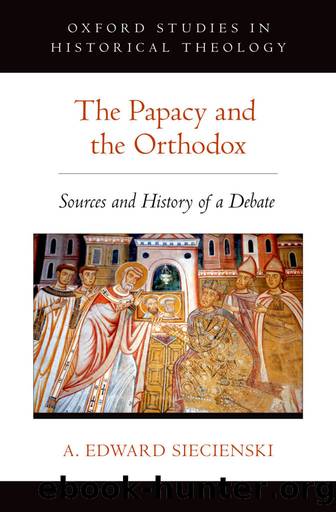The Papacy and the Orthodox (Oxford Studies in Historical Theology) by A. Edward Siecienski

Author:A. Edward Siecienski [Siecienski, A. Edward]
Language: eng
Format: epub
Publisher: Oxford University Press
Published: 2017-01-11T16:00:00+00:00
The Great Schism
The events leading up to the mutual excommunications of Humbert and Cerularius actually had very little to do with the papacy or the contents of Pope Leoâs letters, especially as the patriarch was convinced that Leo did not write them.52 As was made clear in the excommunication itself, the patriarch believed that Humbert was conspiring with Argyrus and that the popeâs letters had been tampered with.53 During their stay in Constantinople the papal representatives dealt chiefly with the emperor, who arranged for Niketas Stethatos to come before Humbert and recant his earlier anti-Latin tract, anathematizing âall those who denied that the Roman Church was the first of all churches (primam omnium ecclesiarum) and who presumed to rebuke its ever-orthodox faith in any respect.â54 Humbertâs attitude was haughty, his language intemperate (e.g., he at one point characterized Niketas as a âpestiferous pimpâ), and he compounded this by re-introducing the thorny issue of the filioque, claiming that the Eastâs omission of the word from the Nicene Creed had brought them into serious heresy.55 This opened the ancient debate, providing Cerularius with a powerful weapon able to unify the Eastern Church against the Latins.
Yet it would be a mistake to blame the schism on the personality of one man. The real issue facing the East, behind the azymes and the filioque, was how to deal with the reformed papacy, for whom Humbert was merely a spokesman. In him and the pamphlets he circulated they encountered a different understanding of the papacy, for âup to this time that had not realized the changes that had taken place in the Roman Church. In all frankness, they simply did not understand them.â56 Perhaps, as Deno Geanakoplos observed, they had become too âaccustomed to the low-prestige and corruption of the tenth century papacyâ and thus âunderestimated the growing strength of the papal reforming party.â57
On July 16 Humbert and his party entered Hagia Sophia just as the liturgy was to begin and placed the bull of excommunication against Patriarch Michael, Leo of Ohrid, and âall their followers in the aforesaid errors and presumptionsâ on the altar.58 The excommunication began with a re-statement of Roman primacy, writing that âthe holy, first, and apostolic see of Rome, to which the care of all the churches most especially pertains as if to a headâ (ad quam tanquam ad caput sollicitudo omnium ecclesiarum specialius pertinent), had sent delegates to Constantinople to investigate matters.59 These delegates found that âwith respect to the pillars of the empire and its wise and honored citizens, the city is most Christian and orthodox,â but judged that âMichael, false neophyte patriarchâ had committed âextremely wicked crimesâ and that âalthough admonished by the letters of our lord Pope Leo, contemptuously refused to repent.â⦠Indeed, so much that among his own children, he had anathematized the apostolic see and against it he still writes that he is the ecumenical patriarch.â60
Although the subdeacons made feverish attempts to return the bull to Humbert, in accordance with the biblical command he
Download
This site does not store any files on its server. We only index and link to content provided by other sites. Please contact the content providers to delete copyright contents if any and email us, we'll remove relevant links or contents immediately.
Resisting Happiness by Matthew Kelly(3287)
The Social Psychology of Inequality by Unknown(2922)
Day by Elie Wiesel(2704)
Designing Your Life by Bill Burnett(2656)
The Giving Tree by Shel Silverstein(2272)
Human Design by Chetan Parkyn(1964)
Angels of God: The Bible, the Church and the Heavenly Hosts by Mike Aquilina(1916)
The Supreme Gift by Paulo Coelho(1882)
Jesus of Nazareth by Joseph Ratzinger(1754)
Hostage to the Devil by Malachi Martin(1740)
Augustine: Conversions to Confessions by Robin Lane Fox(1727)
7 Secrets of Divine Mercy by Vinny Flynn(1674)
Dark Mysteries of the Vatican by H. Paul Jeffers(1660)
The Vatican Pimpernel by Brian Fleming(1652)
St. Thomas Aquinas by G. K. Chesterton(1596)
Saints & Angels by Doreen Virtue(1568)
The Ratline by Philippe Sands(1493)
My Daily Catholic Bible, NABRE by Thigpen Edited by Dr. Paul(1456)
Called to Life by Jacques Philippe(1442)
